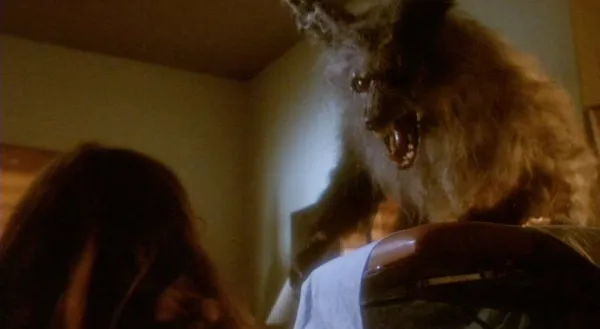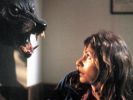Eye For Film >> Movies >> The Howling (1981) Film Review

As most film fans will be aware, there's a tendency for Hollywood to develop sudden obsessions that mean several films on the same subject come out in the same year. Prior to 1981, the best known films about lycanthropy were Lon Chaney Jr's contributions to the Universal horror franchise and Hammer Horro's Oliver Reed vehicle, The Curse Of The Werewolf. The year, three films changed everything. One of them was Wolfen. One was An American Werewolf In London. The other was The Howling.
Though it lacks the polish now associated with director Joe Dante (its roughness wasn't a surprise back when all he was known for was Piranha), The Howling became one of the most influential films of its era. It's most notable for its special effects, which are by far the strongest part of it. Though they share some ideas with those in John Landis' film and would later be echoed, more gorily, in The Company of Wolves, they made an enormous impact in their time and were highly impressive given the materials available to the designers. The Howling's werewolves were very different in style from their peers - hybrid man-wolves rather than four-legged beasts - and they were also different in temperament, marking the first time in cinema that lycanthropes had really revelled in their difference.

The monsters make an impact. The story, not so much. It has little in common with the Gary Brandner book on which it's ostensibly based, but follows the fate of journalist Karen (Dee Wallace), who suffers from amnesia after a traumatic encounter with a serial killer and is sent by her psychiatrist to a woodland retreat which she's told will aid in her recovery, but which is actually home to a sinister cult. Sid Vicious warned that one should never trust a hippy, and whilst these ones may seem harmlessly fond of floaty dresses and wittering on about nature, once the moon rises they're all pointy teeth and oversized chest wigs. They're also fond of commitment-free al fresco sex, something which is a bit much for Karen's sensibilities in itself, and the film has a pivotal place in the history of 'primal' fetish sex.
Though there might seem to be a lot of narrative options here, the first hour of the film is far too slow; the material is spread too thinly and then padded out with silent gazes which fall far short of meaningful. It's also undermined somewhat by a scene in which Karen is casually knocked off her feet by a man because she's dared to get uppity, something too common in films of the period to be seen as clever foreshadowing; instead, it reminds us that the threat of violence is often commonplace in women's lives, leaving us wondering why she makes so much more fuss when those threatening her happen to have a bit of extra body hair. For all that we can accept she's traumatised, her whimpering wears on the nerves, and a key transformation sequence often hailed as one of cinema's scariest moments is let down by her standing there uselessly observing it for ages before taking any kind of action.
The film has parallels with Kathryn Bigelow's 1987 vampire tale Near Dark in the way it presents its monsters as essentially a group of killers living on the fringes of society, an idea which would become much more popular in 21st Century horror. For all the silliness of some of its scenes, there is no doubt that it has been influential, and it's essential viewing for anyone with a serious interest in the history of the genre. Its flaws are leavened somewhat by Dante's trademark humour and once it picks up momentum it makes for entertaining viewing. Its success, however, seems as much accident as design. It tapped into something that was changing, linking sex and violence and ancient myth at a pivotal moment, and in the process became a legend out of all proportion to its quality. Today it doesn't bear the same weight of expectation, but it is in places endearingly ludicrous and in others unexpectedly brilliant.
Reviewed on: 07 Oct 2017



















